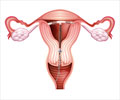A new review has found that when teenagers receive health education and information about contraception, the number of them having unintended pregnancies decreases.
A new review has found that when teenagers receive health education and information about contraception, the number of them having unintended pregnancies decreases.
Unintended pregnancy among adolescents is a common global problem. According to the review, in the United States, 9 percent of adolescents between 15 and 19 years old become pregnant each year. India has even higher rates, where 19 percent of pregnancies are among adolescents."Adolescents who have an unintended pregnancy face a number of challenges, including abandonment by their partners, inability to complete school education and increased adverse pregnancy outcomes," wrote review authors led by Chioma Oringanje of the University of Calabar Teaching Hospital in Nigeria.
The aim of the new review was to evaluate whether pregnancy prevention interventions have an effect on the rate of unintended pregnancies among adolescents.
The review appears in the current issue of The Cochrane Library, a publication of The Cochrane Collaboration, an international organization that evaluates research in all aspects of health care. Systematic reviews draw evidence-based conclusions about medical practice after considering both the content and quality of existing trials on a topic.
Oringanje and fellow Cochrane reviewers evaluated 41 studies involving 95,662 ethnically diverse boys and girls, most between 9 to 19 years old. The studies took place in developed countries predominantly, including the United States, Canada, Italy and England.
Most adolescents received their interventions in school, and the rest took place in hospitals or family planning clinics. The interventions occurred in various formats, such as health education or counseling only, health education plus skills building and health education plus contraception education.
Advertisement
Researchers followed the teens in the studies from three months to 4.5 years.
Advertisement
As far as increasing contraceptive use among adolescents, there was little significant evidence that promoting the use of contraception alone made a difference. None of the studies showed an effect on condom use between intervention and control groups. Two studies, however, showed the rate of hormonal contraceptive use was significantly higher in the intervention group (366 of 1,395) than in the control group (279 of 1,696).
The Cochrane reviewers concluded that all interventions -including education, contraception education and promotion and combinations of the two - reduced unintended pregnancy over the medium and long-term follow up.
Jeanie Alter, program manager and lead evaluator of the Indiana Prevention Resource Center at Indiana University''s School or Health, Physical Education, and Recreation, agreed that multiple interventions work best in curbing this global health problem.
"Comprehensive sexuality education that promotes abstinence while acknowledging that many teens will be sexually active and discusses contraception and STI risks, is the most effective," said Alter. "Evidence shows that comprehensive sexuality education is not related to greater promiscuity, but rather delayed initiation, lower STI rates and reduced teen pregnancy."
Alter added that adolescents in the United States do not receive enough education and contraception promotion in school or in their communities.
"While many European countries provide government funding for comprehensive sexuality education that includes education about abstinence, STIs and contraception, the U.S. government only provides funds for abstinence-only sexuality education," she said. "States have the right to offer comprehensive sexuality education, but must do so without the aid of federal funds."
Source-Newswise
RAS












